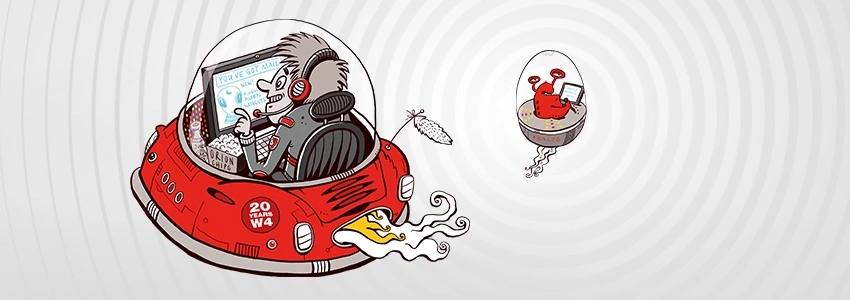A bounced email is a message that can’t be delivered due to permanent errors like a wrong email address. This guide covers the main types of bounces: hard bounce vs. soft bounce, what causes them, their impact, and how to fix bounces.
What you’ll learn:
- A hard bounce indicates a permanent delivery failure, often due to nonexistent email addresses or invalid domains, and requires immediate action.
- A soft bounce indicates a temporary delivery failure, often due to issues like a full inbox, server problems, or message size limits.
- High rates of hard bounces can harm your email deliverability and sender reputation, potentially leading to your emails being classified as spam.
- Unlike hard bounces, soft bounce emails may still be successfully delivered on future attempts.
- Regularly cleaning your email list, using double opt-in methods, and verifying addresses can significantly reduce hard bounces and improve email campaign effectiveness.
Understanding Hard Bounces

A hard bounce occurs when an email is permanently undeliverable due to issues like a nonexistent address or a deactivated mailbox. Unlike a soft bounce, which is a temporary issue, a hard bounce represents a permanent rejection of your email.
Common error messages indicating a hard bounce include ‘Address rejected,’ ‘No such user here,’ and ‘Bad destination mailbox address.’ These messages confirm that delivery is impossible, and retrying won’t change the outcome. Distinguishing between a hard and soft bounce is essential. While soft bounces may resolve over time, hard bounces require prompt removal from your list to protect email deliverability and sender reputation.
Common Causes of Email Bounces
Hard bounces happen due to permanent issues with the recipient’s address, like non-existent or outdated email addresses, invalid domains, or servers rejecting emails from unverified or blacklisted senders. These are final delivery failures, so further attempts won’t succeed.
Soft bounces, however, are temporary delivery issues. They may be caused by a full inbox, server downtime, message size limits, rate limiting, or temporary DNS issues. These typically resolve with time, and redelivery attempts may be successful.
Hard Bounce vs Soft Bounce

Knowing the difference between hard and soft bounces is crucial for email management. Hard bounces signify permanent delivery failures due to invalid addresses or blocked domains, while soft bounces are temporary and might be resolved later.
Remove emails associated with hard bounces from your lists to protect your sender reputation. Soft bounces might resolve themselves and often need redelivery attempts after fixing the temporary issue.
Regular updates to your email lists help manage hard bounces by removing invalid or non-existent addresses. This proactive approach ensures emails reach valid recipients, maintaining the effectiveness of your campaigns.
Impact of Hard Bounces on Email Marketing

High numbers of hard bounces can spell disaster for your email marketing efforts. When emails frequently hard bounce, it raises red flags with spam filters, which can severely impact your email deliverability. That means fewer of your emails will reach your audience, diminishing the effectiveness of your campaigns.
Moreover, hard bounces can lead to your emails being classified as spam by email service providers. This not only affects the current campaign but can also tarnish your sender reputation. Once your reputation is damaged, it’s challenging to regain the trust of email servers, leading to long-term issues with email delivery.
A high bounce rate can also indicate problems with your recipient list, such as outdated or invalid email addresses. This reduces overall engagement metrics and can make your email marketing efforts look less successful than they are. Being listed on a major block list can cause emails to hard bounce, necessitating action to remove the listing.
How to Identify a Hard Bounce Message
Recognizing hard bounce messages is key to maintaining effective email communication and deliverability. Traditional SMTP error code 550 signifies a bad email address, which is a common indicator of a hard bounce. Similarly, enhanced bounce code 5.1.1 specifically refers to a bad destination mailbox address, confirming a hard bounce.
Recognizing these codes allows you to take immediate action, such as removing invalid email addresses from your list. This proactive approach helps improve your sender reputation and the effectiveness of your email marketing campaigns.
Monitoring bounce messages helps ensure your emails reach genuine, active recipients.
Preventing Hard Bounces

A clean email list is the first step in preventing hard bounces. Regular updates and validation help maintain sender credibility by eliminating outdated or invalid addresses, thereby reducing bounce rates. Additionally, email management is crucial for effective communication.
Implementing a double opt-in process when collecting email addresses ensures that only valid addresses are added to your mailing list, reducing the chances of hard bounces. Email verifiers provide instant validation, preventing invalid entries from entering your list.
Verifying email addresses before adding them to your list can significantly reduce the occurrence of hard bounces. These proactive steps ensure your emails reach active, valid recipients, and maintain a healthy subscriber base.
Dealing with Hard Bounces
Addressing hard bounces requires a multi-faceted approach. Removing inactive subscribers improves email deliverability and reduces hard bounces. Segmenting your list based on engagement levels allows for targeted re-engagement strategies.
Keep an eye on your sender reputation; a poor reputation can increase hard bounce rates. Additionally, monitoring email content and formatting before sending is important, as exceeding the size limit can result in hard bounces.
Taking these steps helps ensure that your emails are reaching active, engaged recipients, reducing the likelihood of your domain being blacklisted due to repeated hard bounces and issues with your email server.
Best Practices for Managing Bounce Rates
Sending emails from a custom domain can improve deliverability, as free domains are more likely to be marked as spam. Additionally, utilizing a reliable email service provider, like HubSpot, can significantly improve deliverability and decrease the likelihood of bounces. HubSpot automatically suppresses hard-bounced addresses, preventing repeat attempts to reach invalid contacts, which helps protect your sender reputation. It also offers tools for effective list management, making it easy to remove inactive or invalid subscribers and to segment contacts based on engagement levels.
HubSpot’s integration with email verification services further reduces bounce rates by allowing you to validate emails before they’re added to your list. This, combined with HubSpot's tracking and reporting capabilities, enables you to monitor bounce rates closely and take proactive steps to keep your list healthy. Additionally, pre-sending email tests can identify potential delivery issues and prevent bounces, while avoiding spammy language and content improves deliverability and lowers the risk of being flagged as spam.
Improve Email Deliverability with W4’s HubSpot Expertise
Managing hard bounces is essential for sustaining a successful email marketing strategy. From understanding the causes to implementing preventative steps, each action helps ensure your emails reach their intended recipients, protecting your sender reputation and boosting campaign effectiveness. By following best practices—like routine list maintenance, email verification, and removing invalid addresses—you can reduce hard bounces and enhance deliverability.
As a HubSpot integrations and implementations partner, W4 is uniquely positioned to help you optimize your HubSpot setup to manage and reduce hard bounces effectively. We can configure HubSpot’s automation tools to streamline list cleaning, ensure only verified, active contacts are retained, and set up workflows that automatically suppress hard-bounced addresses. With our expertise, we can also integrate third-party email verification solutions directly into HubSpot, further enhancing your list’s quality and improving deliverability. By leveraging HubSpot’s capabilities alongside W4’s support, you’ll safeguard your sender reputation and maximize the reach and effectiveness of your email marketing efforts.








.webp)

